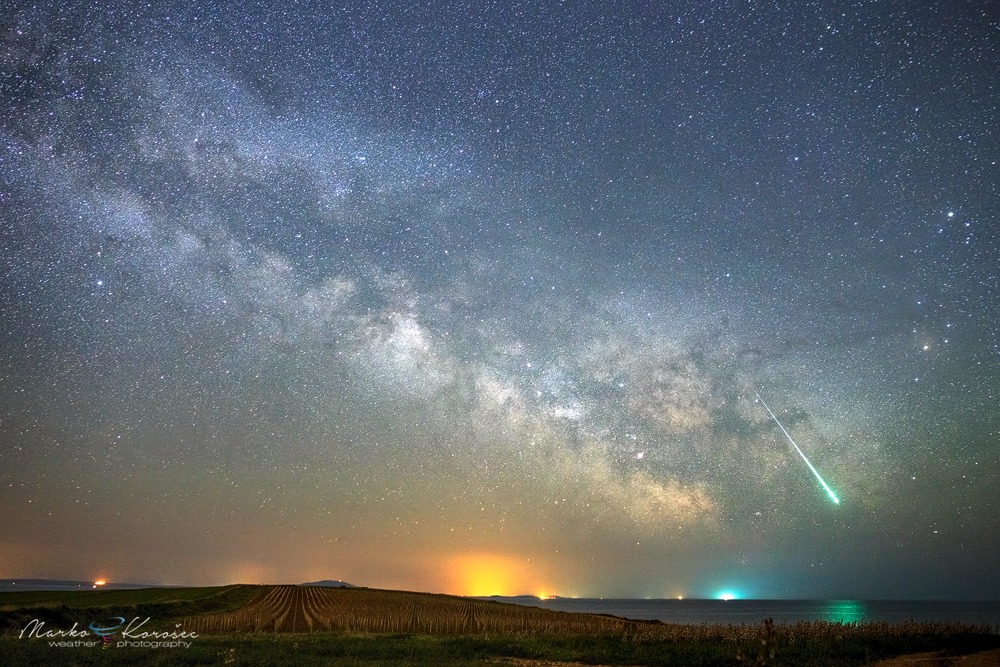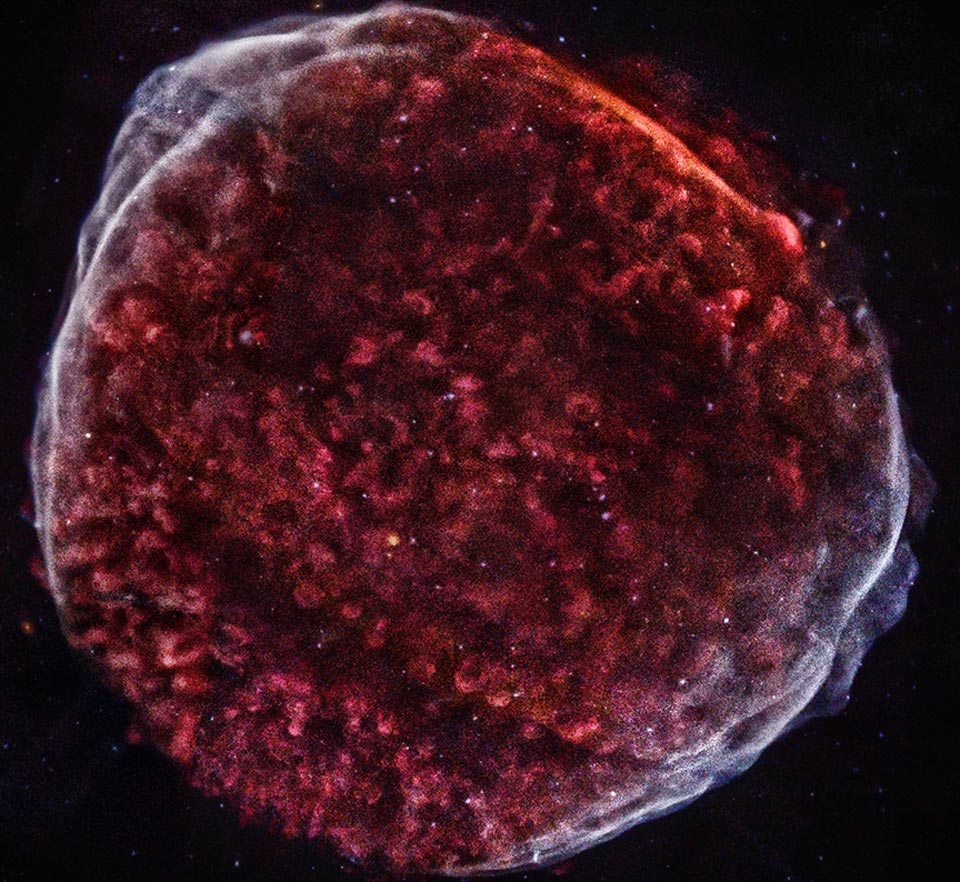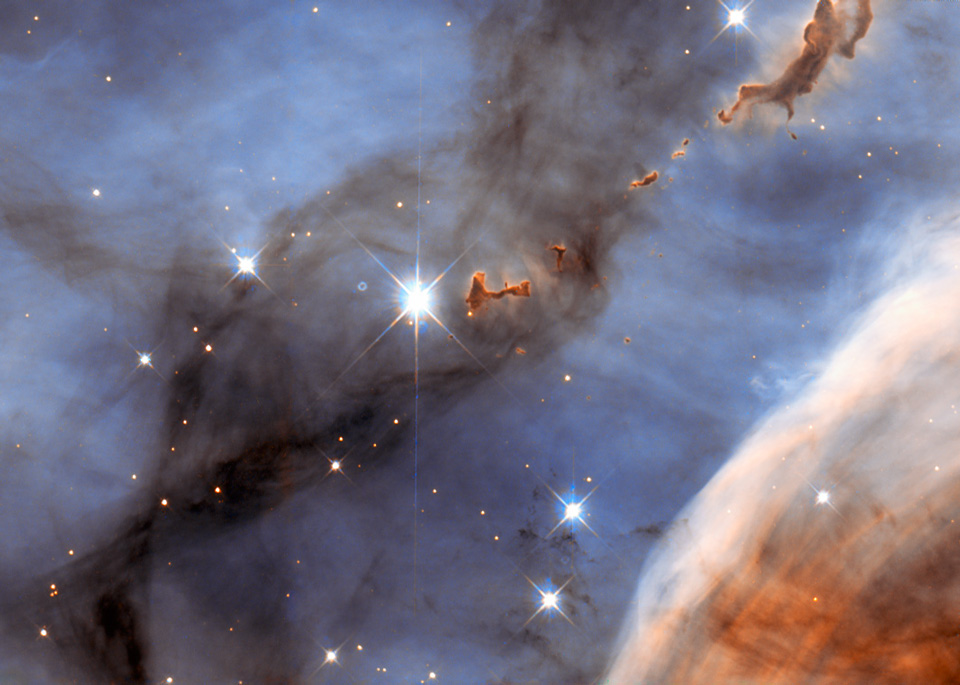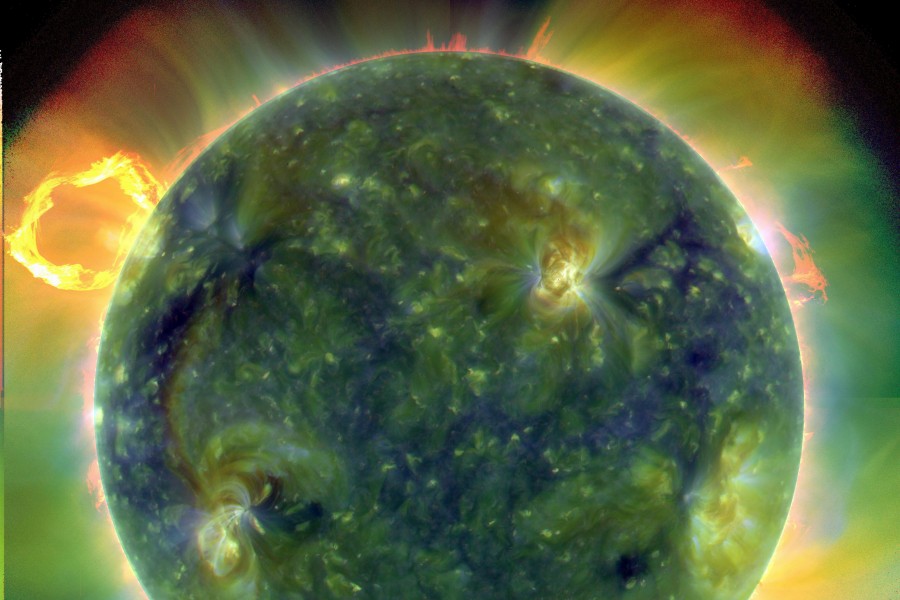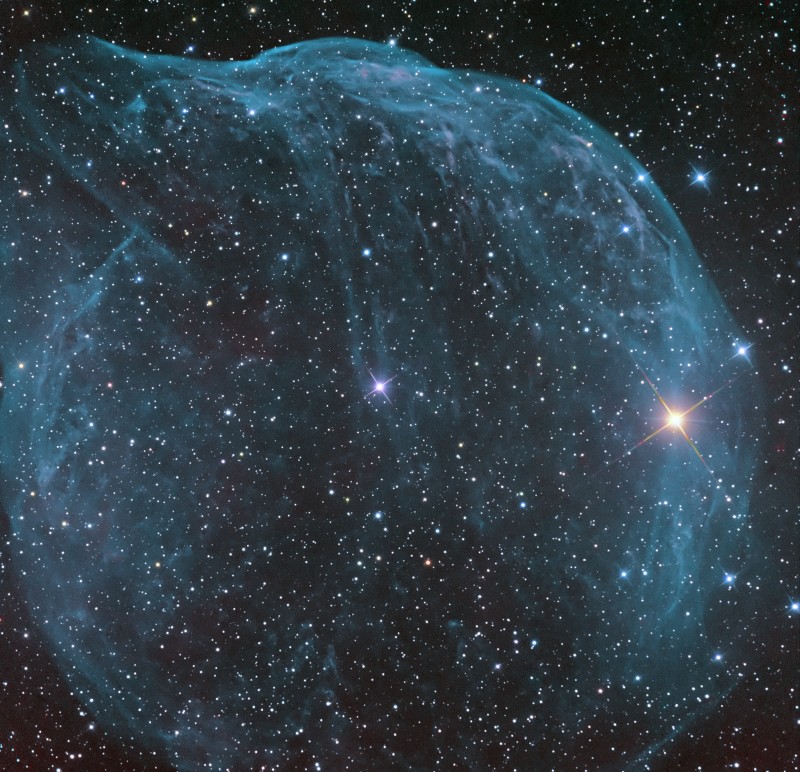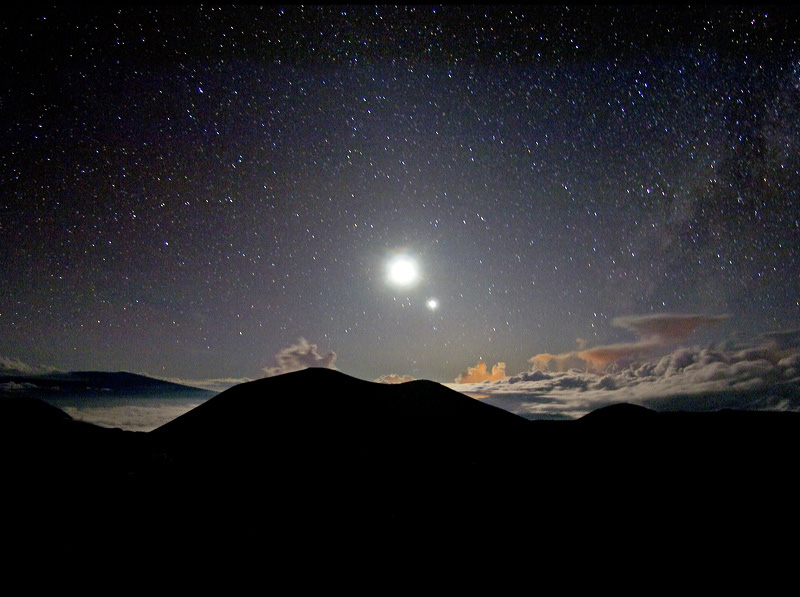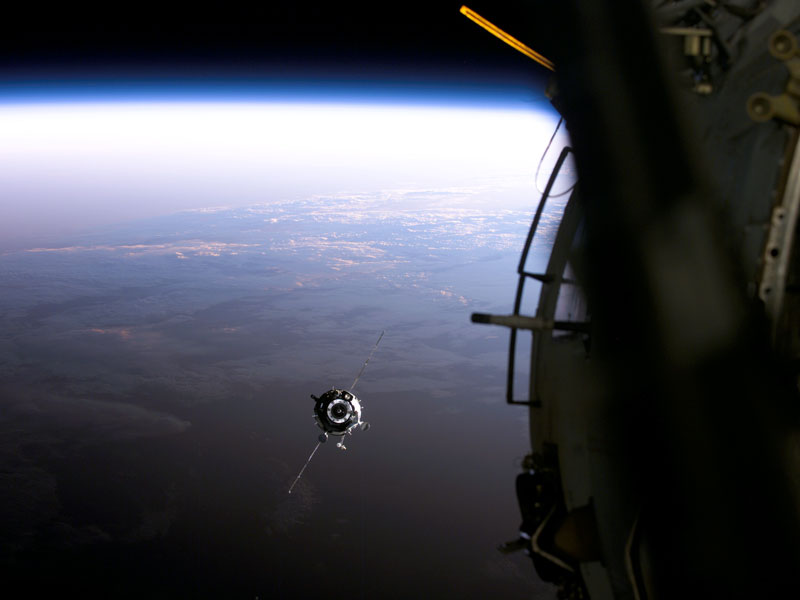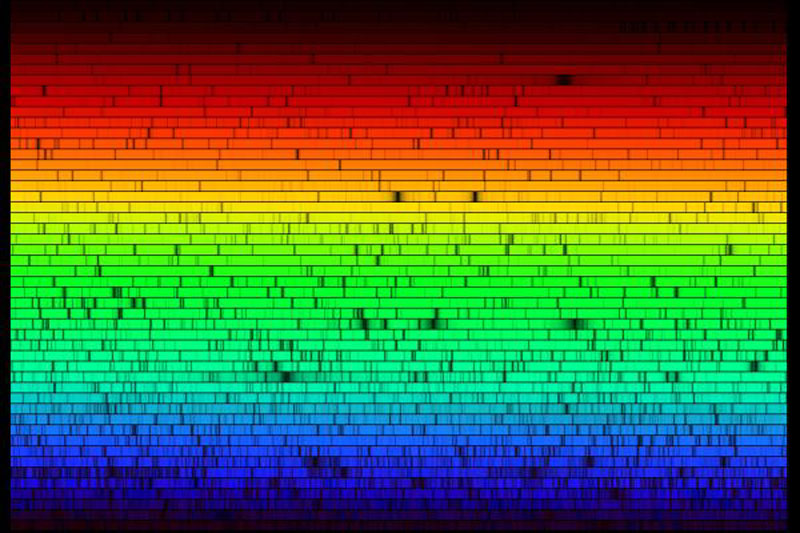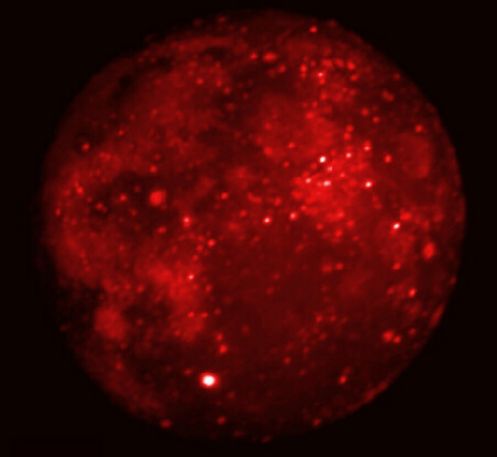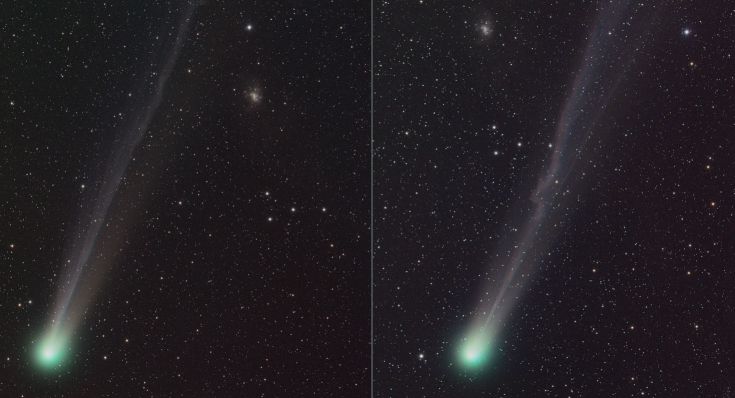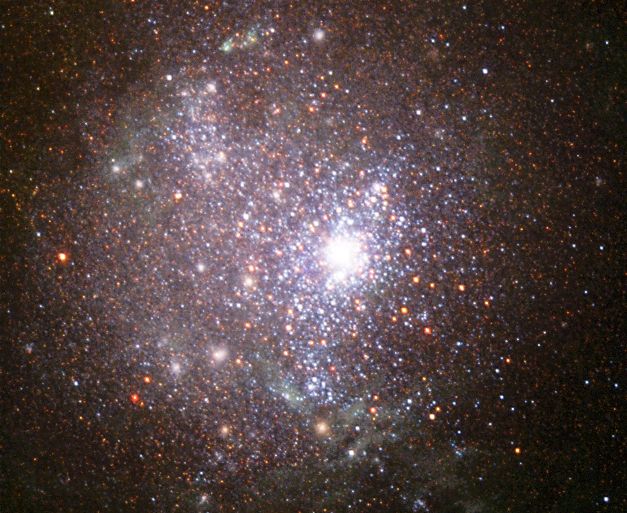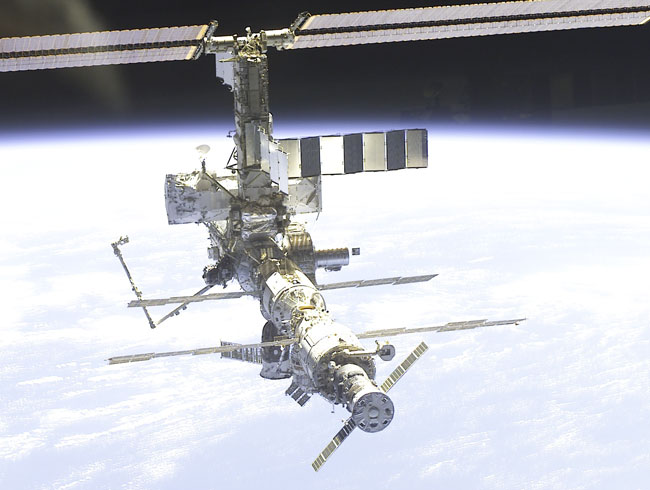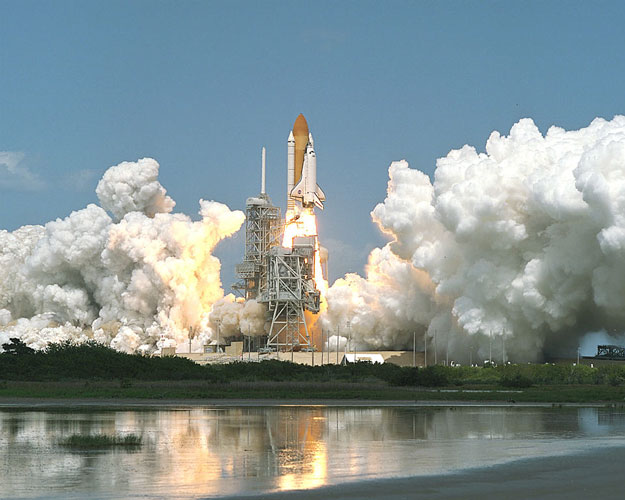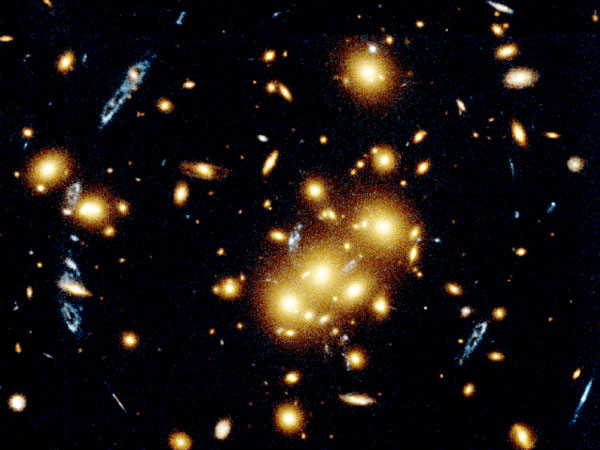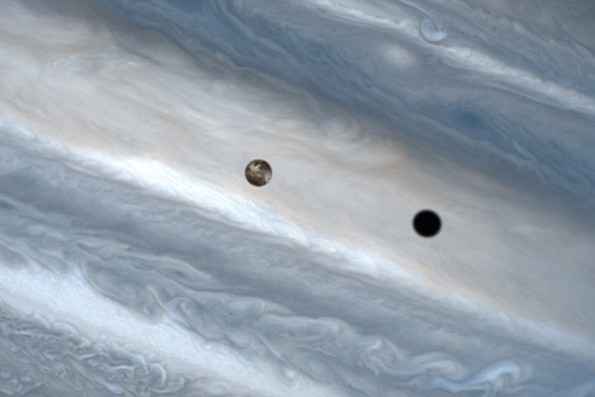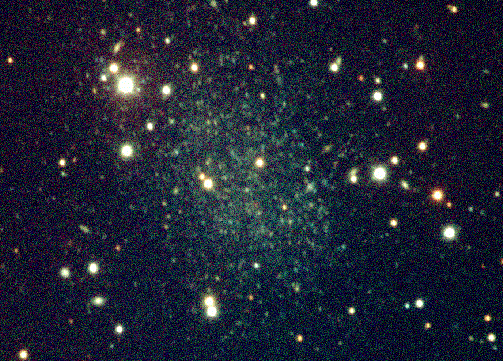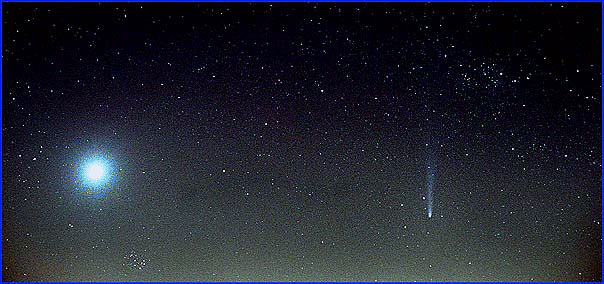| << Previous | Index | Next >> |
2015 Earth's April showers include the Lyrid Meteor Shower, observed for more than 2,000 years when the planet makes its annual passage through the dust stream of long-period Comet Thatcher. A grain of that comet's dust, moving 48 kilometers per second at an altitude of 100 kilometers or so, is swept up in this night sky view from the early hours of April 21. Flashing toward the southeastern horizon, the meteor's brilliant streak crosses the central region of the rising Milky Way. Its trail points back toward the shower's radiant in the constellation Lyra, high in the northern springtime sky and off the top of the frame. The yellowish hue of giant star Antares shines to the right of the Milky Way's bulge. Higher still is bright planet Saturn, near the right edge. Seen from Istra, Croatia, the Lyrid meteor's greenish glow reflects in the waters of the Adriatic Sea.
2014 From planet Earth, we see this strongly distorted pair of galaxies, cataloged as Arp 81, as they were only about 100 million years after their close encounter. The havoc wreaked by their mutual gravitational interaction during the encounter is detailed in this color composite showing twisted streams of gas and dust, a chaos of massive star formation, and a tidal tail stretching for 200 thousand light-years or so as it sweeps behind the cosmic wreckage. Also known as NGC 6622 (left) and NGC 6621, the galaxies are roughly equal in size but are destined to merge into one large galaxy in the distant future, making repeated approaches until they finally coalesce. Located in the constellation Draco, the galaxies are 280 million light-years away. Even more distant background galaxies can be spotted in the sharp, reprocessed, image from Hubble Legacy Archive data.
2013 What looks like a puff-ball is surely the remains of the brightest supernova in recorded human history. In 1006 AD, it was recorded as lighting up the nighttime skies above areas now known as China, Egypt, Iraq, Italy, Japan, and Switzerland. The expanding debris cloud from the stellar explosion, found in the southerly constellation the Wolf (Lupus), still puts on a cosmic light show across the electromagnetic spectrum. In fact, the above image results from three colors of X-rays taken by the orbiting Chandra X-ray Observatory. Now known as the SN 1006 supernova remnant, the debris cloud appears to be about 60 light-years across and is understood to represent the remains of a white dwarf star. Part of a binary star system, the compact white dwarf gradually captured material from its companion star. The buildup in mass finally triggered a thermonuclear explosion that destroyed the dwarf star. Because the distance to the supernova remnant is about 7,000 light-years, that explosion actually happened 7,000 years before the light reached Earth in 1006. Shockwaves in the remnant accelerate particles to extreme energies and are thought to be a source of the mysterious cosmic rays.
2012 No, they are not alive -- but they are dying. The unusual blobs found in the Carina nebula, some of which are seen floating on the upper right, might best be described as evaporating. Energetic light and winds from nearby stars are breaking apart the dark dust grains that make the iconic forms opaque. Ironically the blobs, otherwise known as dark molecular clouds, frequently create in their midst the very stars that later destroy them. The floating space mountains pictured above by the orbiting Hubble Space Telescope span a few light months. The Great Nebula in Carina itself spans about 30 light years, lies about 7,500 light years away, and can be seen with a small telescope toward the constellation of Keel (Carina).
2011 What is it? It's a multi-temporal illumination map, of course. To make it, the wide angle camera on the Lunar Reconnaissance Orbiter spacecraft collected 1,700 images over a period of 6 lunar days (6 Earth months), repeatedly covering an area centered on the Moon's south pole. Converted to binary values (shadowed pixels set to 0, illuminated pixels set to 1) the images were stacked to produce a map representing the percentage of time each spot on the surface was illuminated by the Sun. Remaining convincingly in shadow, the floor of the 19 kilometer diameter Shackleton crater is seen near the center of the map. The lunar south pole itself is at about 9 o'clock on the crater's rim. Since the Moon's axis of rotation stays almost perpendicular to the ecliptic plane, crater floors near the lunar south and north poles can remain in permanent shadow and mountain tops in nearly continuous sunlight. Useful to future outposts, the shadowed crater floors could offer reservoirs of water ice, and the sunlit mountain tops ideal locations for solar power arrays.
2010 Don't panic, the Sun has not gone wild. But this wild-looking portrait of the nearest star to planet Earth was made on March 30th by the recently launched Solar Dynamics Observatory (SDO). Shown in false-color, the composite view covers extreme ultraviolet wavelengths and traces hot plasma at temperatures approaching 1 million kelvins. At full resolution, SDO image data is intended to explore solar activity in unprecedented detail. In fact, SDO will send 1.5 terabytes of data back each day, equivalent to a daily download of about half a million MP3 songs. New SDO data releases include a high-resolution movie of the large, eruptive prominence seen along the solar limb at the upper left.
2009 Blown by fast winds from a hot, massive star, this cosmic bubble is huge. Cataloged as Sharpless 308 it lies some 5,200 light-years away in the constellation Canis Major and covers over 2/3 degree on the sky (compared with 1/2 degree for the Full Moon). That corresponds to a diameter of 60 light-years at its estimated distance. The massive star itself, a Wolf-Rayet star, is the bright blue one near the center of the nebula. Wolf-Rayet stars have over 20 times the mass of the Sun and are thought to be in a brief, pre-supernova phase of massive star evolution. Fast winds from this Wolf-Rayet star create the bubble-shaped nebula as they sweep up slower moving material from an earlier phase of evolution. The windblown nebula has an age of about 70,000 years. Relatively faint emission captured in the expansive image is dominated by the glow of ionized oxygen atoms mapped to bluish hues.
2008 From the windswept peak of Mauna Kea, on the Big Island of Hawaii, your view of the world at night could look like this. At an altitude of about 13,500 feet, the mountain top is silhouetted in the stunning skyscape recorded near dusk in early December of 2005. The volcanic peak rises just above a sea of storm clouds illuminated by a bright Moon. Planet Venus is setting near the Moon as the brilliant evening star. The scene also includes the faint, milky band of our own galaxy's disk of stars and cosmic dust clouds stretching from the horizon into the sky along the right edge of the frame.
2007 Looking out a window of the International Space Station brings breathtaking views. Visible vistas include a vast and colorful Earth, a deep dark sky, and an occasional spaceship sent to visit the station. Visible on September 20 of last year was a Soyuz TMA-9 spacecraft carrying not only supplies but also three new astronauts. A few days before this picture was taken, the U.S. Space Shuttle Atlantis had just departed. The three new approaching astronauts were American Michael E. Lopez-Alegria, Russian Mikhail Tyurin, and Iranian-American Anousheh Ansari. Ms. Ansari visited the International Space Station (ISS) briefly as a paying spaceflight participant for the Federal Space Agency of Russia, and wrote a popular blog about her experiences. Lopez-Alegria would lead the ISS crew dubbed Expedition 14, which included the flight engineer and Soyuz pilot Tyurin, flight engineer American Sunita Williams, and flight engineer German Thomas Reiter. Tyurin returned to the Earth with Lopez-Alegria this past week.
2006 It is still not known why the Sun's light is missing some colors. Shown above are all the visible colors of the Sun, produced by passing the Sun's light through a prism-like device. The above spectrum was created at the McMath-Pierce Solar Observatory and shows, first off, that although our yellow-appearing Sun emits light of nearly every color, it does indeed appear brightest in yellow-green light. The dark patches in the above spectrum arise from gas at or above the Sun's surface absorbing sunlight emitted below. Since different types of gas absorb different colors of light, it is possible to determine what gasses compose the Sun. Helium, for example, was first discovered in 1870 on a solar spectrum and only later found here on Earth. Today, the majority of spectral absorption lines have been identified - but not all.
2005 In September of 1996, the Midcourse Space Experiment (MSX) satellite had a spectacular view of a total lunar eclipse from Earth orbit. SPIRIT III, an on board infrared telescope, was used to repeatedly image the moon during the eclipse. Above is one of the images taken during the 70 minute totality, the Moon completely immersed in the Earth's shadow. Infrared light has wavelengths longer than visible light - humans can not see it but feel it as heat. So, the bright spots correspond to the warm areas on the lunar surface, and dark areas are cooler. The brightest spot below and left of center is the crater Tycho, while the dark region at the upper right is the Mare Crisium. Of course, this Sunday's lunar eclipse will not be a total, or even a partial one. Instead, the Moon will glide through the subtle outer portion of the Earth's shadow in a penumbral eclipse of the Moon.
2004 Inbound from the distant solar system, comet C/2001 Q4 will soon pass just inside planet Earth's orbit and should be one of two bright, naked-eye comets visible in southern skies in May. First picked up nearly three years ago by the Near Earth Asteroid Tracking (NEAT) project Q4 appears in both of these stunning telescopic views recorded only a few days ago, on April 18th (left) and 19th, from a site near Alcohuaz, Chile. Remarkable changes in the structure of the long, graceful tail can be seen by comparing the two photos, including the dramatic kink seen near the tail's midpoint on April 19th. The apparent motion of the comet sweeping across the sky is evident when you compare the position of the tail relative to background galaxy NGC 1313, visible as a smudge near the top of each image. Q4's closest approach to the Sun will be on May 15th while its closest encounter with planet Earth will be on May 7th (see animation by L. Koehn).
2003 Some 2,000 light-years across, NGC 1705 is small as galaxies go, similar to our Milky Way's own satellite galaxies, the Magellanic Clouds. At a much larger distance of 17 million light-years, the stars of NGC 1705 are still easily resolved in this beautiful image constructed from data taken in 1999 and 2000 with the Hubble Space Telescope. Most of the younger, hot, blue stars in the galaxy are seen to be concentrated in a large central star cluster with the older, cooler, red stars more evenly distributed. Possibly 13 billion years old, NGC 1705 could well have been forming stars through out its lifetime while light from its most recent burst of star formation reached Earth only 30 million years ago. This gradually evolving dwarf irregular galaxy lacks organized structures like spiral arms and is thought to be a nearby analog to the first galaxies to form in the early Universe.
2002 What does the developing International Space Station (ISS) look like now? After delivering and deploying a crucial first backbone-like component last week, the Space Shuttle Atlantis took an inspection lap around the space station. The newly installed truss is visible toward the center of the above image. Also visible are many different types of modules, a robotic arm, several wing-like solar panels, and a supply ship. Construction began on the ISS in 1998 and the core structure should be in place before 2005.
2001 Last Thursday, Space Shuttle Endeavor lifted off on course for the latest round of building the International Space Station (ISS) in orbit around Earth. One of the highlights of the 11-day mission promises to be the installation of Canadarm2, a robotic arm that will assist in the future construction and utilization of the ISS. Canadarm2, a larger and more sophisticated version of the shuttle's own robotic arm, will be able to move around the station's exterior. This is the ninth shuttle mission to build the ISS -- many more are planned over the next several years. When completed, the ISS should enclose about the same room as the passenger cabin of a 747 jet.
2000 What are those strange blue objects? Many are images of a single, unusual, beaded, blue, ring-like galaxy which just happens to line-up behind a giant cluster of galaxies. Cluster galaxies here appear yellow and -- together with the cluster's dark matter -- act as a gravitational lens. A gravitational lens can create several images of background galaxies, analogous to the many points of light one would see while looking through a wine glass at a distant street light. The distinctive shape of this background galaxy -- which is probably just forming -- has allowed astronomers to deduce that it has separate images at 4, 8, 9 and 10 o'clock, from the center of the cluster. Possibly even the blue smudge just left of center is yet another image! This spectacular photo from the Hubble Space Telescope was taken in October 1994.
1999 Orbiting Jupiter once every 43 hours, the volcanic moon Io cruises 500,000 kilometers above swirling, banded cloud-tops. Orbiting Earth once every 1.5 hours, the Hubble Space Telescope watched as Io accompanied by its shadow crossed the face of the reigning gas giant planet in 1997. This and other sharp false-color images have recently been chosen to celebrate the ninth anniversary of the Hubble's launch (April 24, 1990). Reflective patches of sulfur dioxide "frost" are visible on Io's surface while Io's round dark shadow is seen passing over brownish white regions of Jupiter's high altitude haze and clouds. In October and November of this year, the Galileo spacecraft currently operating in the Jovian system is scheduled to make two daring close approaches to Io, possibly flying through a volcanic plume.
1998 These separate radio images reveal three dusty debris disks surrounding three bright, young, nearby stars - evidence for solar systems in formation. From left to right are the stars Fomalhaut, Beta Pictoris, and Vega, their positions indicated by star symbols. The false color maps show the intensity of submillimeter radio emission from the surrounding dust. Next to each dust "disk", a vertical bar illustrates the present size of our own solar system. These observations are likely examples of what our solar system would have looked like to distant radio astronomers when it was only a few hundred million years old! Astronomers speculate that bright blobs of emission near Vega and Beta Pictoris may represent dust clouds around developing giant planets. The radio images were made using detectors cooled to near absolute zero and the James Clerk Maxwell Telescope at Mauna Kea Observatory in Hawaii.
1997 Meet Antlia, a newly discovered neighbor of our Milky Way Galaxy. Announced just last week, this faint member of our Local Group of Galaxies has only about one million stars. It is late in being noticed because it is so hard to see against a bright sky. This faint galaxy is seen here in the background - the bright stars visible are in our own galaxy. The Antlia Dwarf Galaxy is actually a dwarf spheroidal galaxy, similar to nine known dwarf spheroidals that orbit our Milky Way Galaxy. Antlia, named for the constellation in which it resides, is unusual because it does not hover near either of the two major galaxies of the Local Group: our Milky Way Galaxy and M31.
1996 It was a starry night in April (April 9th, 1996, 9:32 pm CDT to be exact) near Lone Jack, Missouri when Comet Hyakutake graced this astronomically rich field. Making an appearance as the brilliant evening star, Venus is overexposed at the far left. Just below Venus and slightly to the right, the Pleiades star cluster (M45) glistens. On the right hand side of the image, the comet itself shows a bright blue tail extending upwards past the nearby star cluster in the constellation Perseus (top right, the Alpha Persei Group). Hyakutake, receding from the Earth and appoaching the Sun, will sink into the western horizon at sunset in late April, disappearing from Northern Hemisphere skies.
| << Previous | Index | Next >> |
